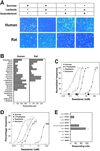Human receptors for sweet and umami taste
- PMID: 11917125
- PMCID: PMC123709
- DOI: 10.1073/pnas.072090199
Human receptors for sweet and umami taste
Abstract
The three members of the T1R class of taste-specific G protein-coupled receptors have been hypothesized to function in combination as heterodimeric sweet taste receptors. Here we show that human T1R2/T1R3 recognizes diverse natural and synthetic sweeteners. In contrast, human T1R1/T1R3 responds to the umami taste stimulus l-glutamate, and this response is enhanced by 5'-ribonucleotides, a hallmark of umami taste. The ligand specificities of rat T1R2/T1R3 and T1R1/T1R3 correspond to those of their human counterparts. These findings implicate the T1Rs in umami taste and suggest that sweet and umami taste receptors share a common subunit.
Figures



References
-
- Hoon M A, Adler E, Lindemeier J, Battey J F, Ryba N J, Zuker C S. Cell. 1999;96:541–551. - PubMed
-
- Kitagawa M, Kusakabe Y, Miura H, Ninomiya Y, Hino A. Biochem Biophys Res Commun. 2001;283:236–242. - PubMed
-
- Max M, Shanker Y G, Huang L, Rong M, Liu Z, Campagne F, Weinstein H, Damak S, Margolskee R F. Nat Genet. 2001;28:58–63. - PubMed
-
- Montmayeur J P, Liberles S D, Matsunami H, Buck L B. Nat Neurosci. 2001;4:492–498. - PubMed
-
- Sainz E, Korley J N, Battey J F, Sullivan S L. J Neurochem. 2001;77:896–903. - PubMed
MeSH terms
Substances
Associated data
- Actions
- Actions
- Actions
- Actions
- Actions
- Actions
LinkOut - more resources
Full Text Sources
Other Literature Sources
Molecular Biology Databases

